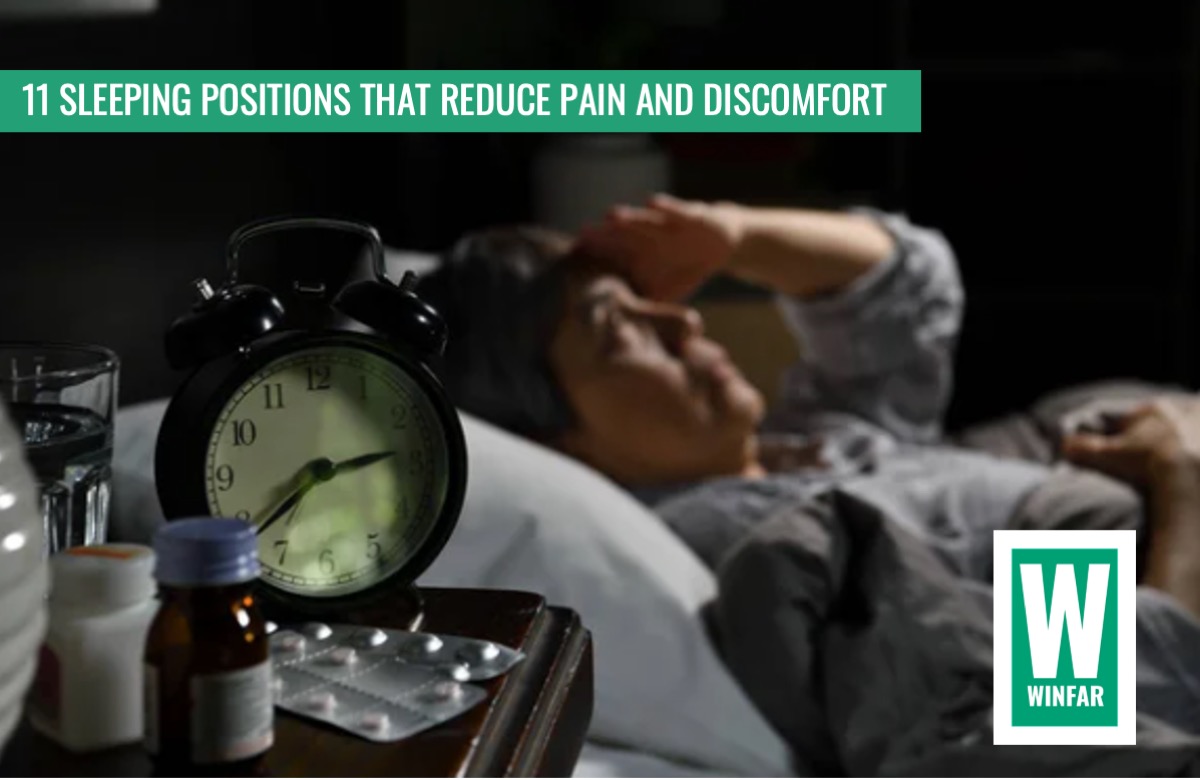There are many reasons why seniors wake at night, but a top one is chronic pain.
If you’re sleeping in a position that doesn’t properly support your body, it can create extra pressure that increases pain. By aligning and supporting your body, you will sleep more comfortably.
Daily Caring, Mayo Clinic and Health Line have pulled together some useful tips for adjusting your sleep position so that it better supports your body and reduces pain at night. These tips cover side, back, and stomach sleeping as well as a variety of health conditions like back pain due to spinal issues, neck or hip pain, acid reflux, and more…
Focus on comfortable body alignment for older bodies
The overall goal is to keep your body in an aligned, neutral position as much as possible while you sleep.
For younger adults, that means the spine is straight and the lower back is in its natural, slightly curved position.
But with older adults, age and chronic health conditions may have caused aches and pains along with changing the shape of their body.
Consequently, a comfortable alignment for older adults, is different from what works for a younger adult body.
For example, seniors with kyphosis (rounded back), won’t be able to lie flat on their back. A comfortable sleep position for them may be on their side with their spine supported as it is (curved), not trying to straighten it out.
These tips are starting points to help you find a comfortable sleeping position.
To find one that suits your body and personal preferences, experiment and adjust until you find a position that works well for you. And to avoid any chance of injury, it’s always best to check with their doctor before trying something new.
Note: You can use folded or rolled towels or blankets to get the same effect as pillows. That can help if you’re still experimenting and don’t want to buy extra pillows before finding a position that works. It also assumes that you have a comfortable, supportive mattress.
11 tips to improve senior sleep by reducing pain and discomfort
1. For side sleepers
At 7 minutes 32 seconds in this video, physical therapists demonstrate how to achieve a well-supported sleep position for a side sleeper.
Key points:
– Use enough pillows under the head to keep it in a neutral (middle) position, which keeps the spine aligned from neck to body
– To reduce pressure on the lower shoulder, add a pillow under the torso, leaving space for the arm (8 min 34 sec in video)
– Add a pillow between the knees or lower legs to keep the hips, pelvis, and spine aligned
– To reduce pressure on the upper shoulder, add a pillow under that arm (9 min 20 sec in video)
2. For back sleepers
At 6 min 43 sec in this video, physical therapists demonstrate how to achieve a well-supported sleep position for a back sleeper.
Key points:
– Don’t use too many pillows under the head so the neck isn’t forced to bend forward
– Add a pillow or a leg wedge under the knees to keep the lower back in a neutral position
3. For stomach sleepers or degenerative disk disease
Generally, sleeping on the stomach isn’t recommended because it’s hard on the back, but long-held habits can be tough to break. However, stomach sleeping may be helpful for people with degenerative disk disease (see #3 in this list). This video shows how to give better support while sleeping on the stomach to keep the spine in a neutral position.
Key points:
– Use a very thin pillow under the head or no pillow at all
– Place a thin or medium pillow under the stomach or pelvis
– Bring one leg to side and slightly bend it, put a pillow under this knee
This image shows another option for stomach sleepers with the emphasis on the pillow under the stomach and pelvis.
4. For general back pain
To relieve back pain, it’s best to sleep on the side or back, following the tips in #1 and #2 above.
5. For those who prefer a reclining chair or for isthmic spondylolisthesis
Some older adults might just prefer to sleep in a reclining chair.
Sleeping in a reclined position is also helpful for a spinal condition called isthmic spondylolisthesis. That’s where one of the lower vertebra slips forward onto the bone directly beneath it.
Sleeping in a reclined position (#5 in this list) takes pressure off the spine.
A bed wedge is an inexpensive option that mimics a recliner chair’s shape. A more expensive option is to consider an adjustable bed.
6. For herniated disk
A helpful sleeping position for back pain caused by a herniated disk is the fetal position, #2 in this list. Sleeping curled up opens the space between the vertebrae.
7. For general neck pain
The best sleeping positions for neck pain are the back or side because they keep the neck and spine aligned with the body. Use the correct pillow height, following the tips for side and back sleepers in #1 & 2 above.
It’s best to avoid stomach sleeping because the head is twisted to the side, which puts pressure on nerves in the neck.
8. For general hip pain
For hip pain, sleep on the “good” side with knees bent. Use the side sleeping tips in #1 above to keep the hips, pelvis, and spine aligned.
9. For general knee pain
To ease knee pain, sleep on the side or back using the tips in #1 and 2 above and keep the knee in a comfortable, slightly bent position.
10. For general shoulder pain
To relieve shoulder pain, have your older adult sleep on their back with a small pillow under the painful shoulder.
Or, sleep on the side on the “good” shoulder and follow the tips in #1 above.
11. For heartburn or GERD
To relieve the discomfort of heartburn or GERD while sleeping, it helps to sleep on the left side and elevate the head of the bed to create an incline. Or, use a bed wedge to put the head and torso on an incline.
Avoid using extra pillows under the head because that doesn’t put the stomach area on an incline, which is what helps the stomach acid stay down in the stomach.
Resources:
https://www.healthline.com/health/healthy-sleep/best-sleeping-position-for-lower-back-pain#pillow-between-your-knees2
https://www.mayoclinic.org/diseases-conditions/back-pain/in-depth/sleeping-positions/art-20546852?s=3
https://dailycaring.com/11-tips-to-improve-senior-sleep-by-reducing-pain-and-discomfort/

